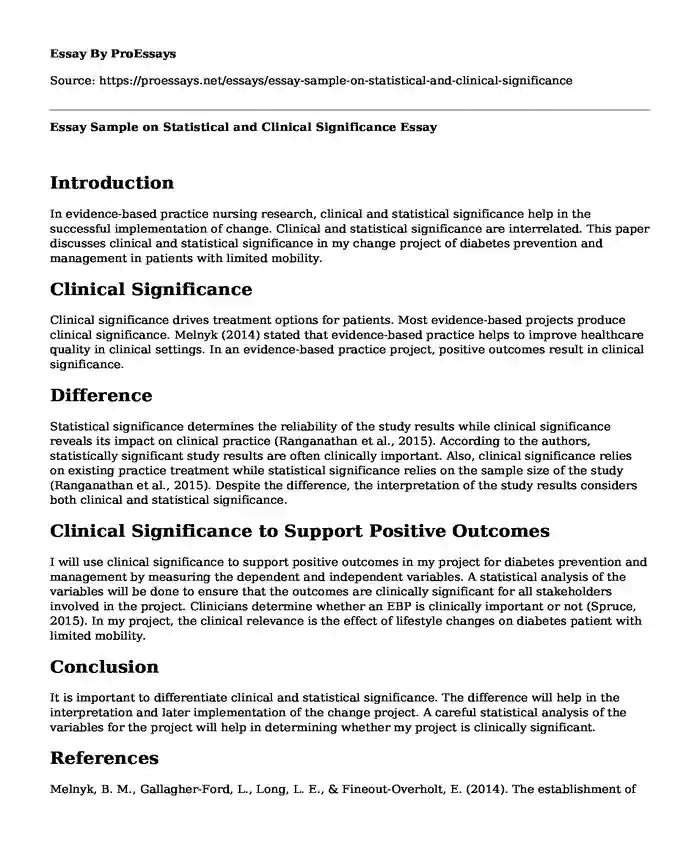Introduction
In evidence-based practice nursing research, clinical and statistical significance help in the successful implementation of change. Clinical and statistical significance are interrelated. This paper discusses clinical and statistical significance in my change project of diabetes prevention and management in patients with limited mobility.
Clinical Significance
Clinical significance drives treatment options for patients. Most evidence-based projects produce clinical significance. Melnyk (2014) stated that evidence-based practice helps to improve healthcare quality in clinical settings. In an evidence-based practice project, positive outcomes result in clinical significance.
Difference
Statistical significance determines the reliability of the study results while clinical significance reveals its impact on clinical practice (Ranganathan et al., 2015). According to the authors, statistically significant study results are often clinically important. Also, clinical significance relies on existing practice treatment while statistical significance relies on the sample size of the study (Ranganathan et al., 2015). Despite the difference, the interpretation of the study results considers both clinical and statistical significance.
Clinical Significance to Support Positive Outcomes
I will use clinical significance to support positive outcomes in my project for diabetes prevention and management by measuring the dependent and independent variables. A statistical analysis of the variables will be done to ensure that the outcomes are clinically significant for all stakeholders involved in the project. Clinicians determine whether an EBP is clinically important or not (Spruce, 2015). In my project, the clinical relevance is the effect of lifestyle changes on diabetes patient with limited mobility.
Conclusion
It is important to differentiate clinical and statistical significance. The difference will help in the interpretation and later implementation of the change project. A careful statistical analysis of the variables for the project will help in determining whether my project is clinically significant.
References
Melnyk, B. M., Gallagher-Ford, L., Long, L. E., & Fineout-Overholt, E. (2014). The establishment of evidence-based practice competencies for practicing registered nurses and advanced practice nurses in real-world clinical settings: Proficiencies to improve healthcare quality, reliability, patient outcomes, and costs. Worldviews on Evidence-Based Nursing, 11(1), 5–15.
https://doi.org/10.1111/wvn.12021
Ranganathan, P., Pramesh, C. S., & Buyse, M. (2015). Common pitfalls in statistical analysis: Clinical versus statistical significance. Perspectives in clinical research, 6(3), 169–170.
https://doi.org/10.4103/2229-3485.159943
Spruce, L., Van Wicklin, S. A., Hicks, R. W., Conner, R., & Dunn, D. (2014). Introducing AORN's new model for evidence rating. AORN journal, 99(2), 243–255.
https://doi.org/10.1016/j.aorn.2013.11.014.
Cite this page
Essay Sample on Statistical and Clinical Significance. (2023, Dec 08). Retrieved from https://proessays.net/essays/essay-sample-on-statistical-and-clinical-significance
If you are the original author of this essay and no longer wish to have it published on the ProEssays website, please click below to request its removal:
- Research Paper Example on the Impact of Food Sources on Obesity Risks Among Adults and Children
- Film Analysis Essay on Still Alice: The Theme of Alzheimer's Disorder
- The Prevalence of Comorbid Depression in Adults With Type 2 Diabetes Paper Example
- Collaboration and Leadership for Effective Emergency Management - Article Analysis Essay
- Medical Rhetoric Analysis Essay: What Are the Health Benefits of Being Creative?
- Paper Example on Health Benefits of Walking for Older Adults: A Limited-Bias Study
- Free Essay Sample on Understanding Social Determinants & Cultural Awareness in Healthcare







